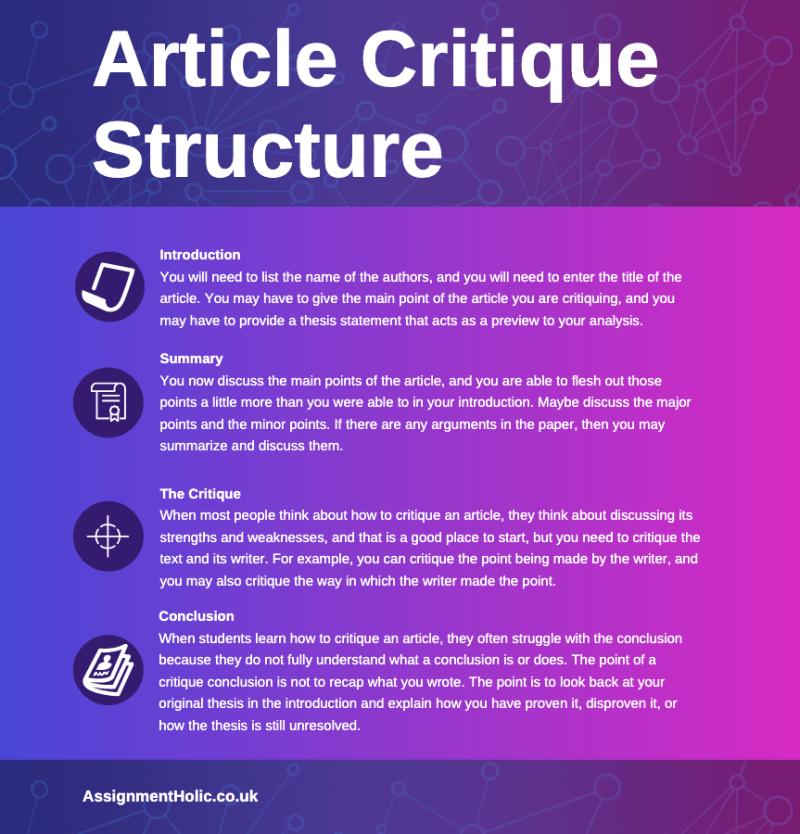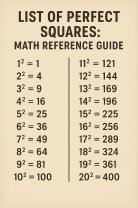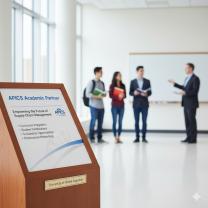What is article Critique?
An article critique is a written analysis and evaluation of a scholarly article. The purpose of a critique is to assess the strengths and weaknesses of the article's arguments, methodology, results, and overall contribution to the field of study. Critiques are common assignments in academic settings, requiring students and scholars to engage critically with research articles and express their informed opinions.
Here are key components of an article critique:
Introduction:
- Provide a brief overview of the article, including the author's name, title of the article, publication information, and a statement of your main point or thesis. The introduction sets the stage for the rest of the critique.
Summary:
- Summarize the main points and arguments of the article. This should be concise and focused on the key elements, such as the research question, methodology, results, and conclusions.
Evaluation of the Title and Abstract:
- Assess the clarity and appropriateness of the article's title and abstract. Consider whether they accurately reflect the content of the research and entice the reader to explore further.
Statement of the Research Problem:
- Evaluate how well the author presents and justifies the research problem or question. Consider the significance of the research within the broader context of the field.
Literature Review:
- Analyze the literature review provided in the article. Assess the author's ability to situate the study within existing research, identify gaps, and highlight the relevance of the study.
Methodology:
- Examine the research design, data collection methods, and analytical techniques employed by the author. Assess the appropriateness of the methodology for addressing the research question and potential limitations.
Results:
- Evaluate the presentation of results. Consider whether the data analysis is clear, whether appropriate statistical methods are used, and how well the results address the research question.
Discussion and Conclusions:
- Assess the author's interpretation of the results and the conclusions drawn. Consider whether the findings align with the research question and if the limitations are adequately acknowledged.
Contributions to the Field:
- Evaluate the article's overall contribution to the field. Consider whether the research adds new knowledge, challenges existing theories, or suggests avenues for future research.
Writing Style and Clarity:
- Assess the author's writing style, clarity, and organization. Evaluate how well the article communicates complex ideas and whether the language is accessible to the intended audience.
Citations and References:
- Check the accuracy and completeness of citations and references. Ensure that the author appropriately credits prior research and provides a comprehensive list of references.
Conclusion:
- Summarize your main critiques and conclude with your overall assessment of the article. Offer suggestions for improvement if relevant.
A well-constructed article critique requires a thoughtful and balanced analysis of the article's various components. It provides the reader with insights into the quality and validity of the research and serves as a valuable exercise in critical thinking within academic contexts.
Understanding the purpose and format of article critiques
Article critiques serve as a valuable tool for evaluating and assessing the quality and significance of scholarly articles. They provide a structured approach to analyzing the content, methodology, and overall contribution of a particular piece of research. Critiques help readers to:
- Gain a deeper understanding of the article's main arguments and conclusions.
- Identify the strengths and weaknesses of the research methodology.
- Assess the validity and reliability of the findings.
- Evaluate the contribution of the article to the field of study.
The format of an article critique typically includes the following elements:
Introduction: This section provides a brief overview of the article, including the author(s), title, publication date, and main research question.
Summary: This section summarizes the key points of the article, including the main arguments, findings, and conclusions.
Critique: This section is the core of the critique and involves a critical evaluation of the article's strengths and weaknesses. It should address aspects such as the research methodology, data analysis, discussion of findings, and overall contribution to the field.
Conclusion: This section summarizes the overall assessment of the article and provides a final judgment on its value and contribution to the field of study.
Identifying the key elements of an effective article critique
An effective article critique should exhibit the following characteristics:
Clarity and conciseness: The critique should be clearly written and easy to understand, using concise language and avoiding unnecessary jargon.
Critical thinking: The critique should demonstrate a thoughtful and analytical approach to evaluating the article, identifying both its strengths and weaknesses.
Evidence-based evaluation: The critique should support its arguments and conclusions with specific evidence from the article, using appropriate citations and referencing.
Objectivity and impartiality: The critique should be objective and unbiased, avoiding personal opinions or biases that could influence the evaluation.
Developing a critical framework for evaluating the strengths and weaknesses of an article
To effectively evaluate an article's strengths and weaknesses, consider the following












